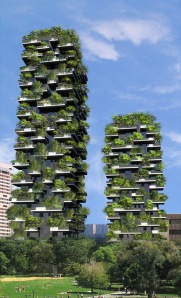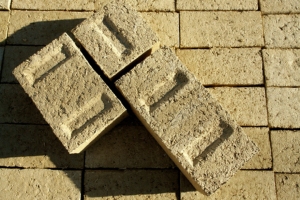With the global population increasing exponentially and a planetary ecosystem in jeopardy, sustainable living solutions are becoming ever more important. Fortunately, necessity is a great catalyst for invention and innovation, and many of the best thinkers have risen to the challenge. Here are five exciting new ideas currently gaining momentum in the world of green architecture!
1. Verdant Surfaces
Also called Vegitecture, this involves integrating organic, planted spaces into the structure of buildings. This has a variety of benefits, from air purification, to soundproofing, to aesthetics and comfort, to insulation and even growing vegetables. Bosco Verticale in Milan, Italy (right) is a wonderful example; currently under construction, this ‘Vertical Forest‘ (the literal translation) consists of two residential tower blocks festooned with a series of concrete decks, on which 2.5 acres of trees and shrubs are currently being established. As well as shading and cooling the residents within, this will absorb CO2 and help with Milan’s long-term dust problem.
A smaller scale example is Casa CorManca – a modern, sustainable home in Mexico City, which includes an internal, three-storey verdant wall in an inner courtyard – helping to control the temperature and air quality, and providing a serene and organic element to the feel of the home.
2. Radiant Heating & Cooling
An alternative to air conditioning, radiant heating and cooling work by controlling the temperature of an indoor surface, by circulating water within embedded plastic or aluminium piping. This takes advantage of the principle of radiative heat transfer: if the surface is cooler than the room, heat is automatically taken away (radiant cooling) and likewise, if the surface is hotter than the ambient temperature, heat will be transferred back into the room (radiant heating).
In India, where air conditioning accounts for 30-40% of energy consumption, this idea has really taken hold. The Hyderabad Campus in Andhra Pradesh, for example, was built in two huge, identical wings. This provided the perfect testing grounds to make a comparison, and Infosys, the company responsible for the build, took full advantage of the opportunity. One wing was fitted with conventional air conditioning, the other with radiant cooling systems. Upon testing, it was found that the radiant cooled half of the building consumed 38% less energy, and even turned out to be slightly cheaper to build than its conventional, air conditioned counterpart.
3. Tiny Homes
The smaller the house, the smaller the footprint!
 This principle has lead many green enthusiasts to make the move to a more compact way of of living, and driven some wonderful innovations in space management. These range from the conceptual and experimental (Isolée), to the very basic (MetaPod), to the down to earth and wonderfully practical (Clothesline Tiny Homes). The concept has even worked for entire families – as demonstrated by Hari and Karl and their 2 children, who built their own tiny home in the Blue Ridge Mountains, Georgia for a mere $12,000 – which highlights another benefit of tiny homes: dramatically reduced costs. Many converts to tiny living will build their own home, and even after buying a plot of land and the cost of materials and labour, tiny homes are still much cheaper than buying a ready built home – especially when you factor in the marginal costs of heating and cleaning a much smaller space.
This principle has lead many green enthusiasts to make the move to a more compact way of of living, and driven some wonderful innovations in space management. These range from the conceptual and experimental (Isolée), to the very basic (MetaPod), to the down to earth and wonderfully practical (Clothesline Tiny Homes). The concept has even worked for entire families – as demonstrated by Hari and Karl and their 2 children, who built their own tiny home in the Blue Ridge Mountains, Georgia for a mere $12,000 – which highlights another benefit of tiny homes: dramatically reduced costs. Many converts to tiny living will build their own home, and even after buying a plot of land and the cost of materials and labour, tiny homes are still much cheaper than buying a ready built home – especially when you factor in the marginal costs of heating and cleaning a much smaller space.
4. Green Building Materials
The materials used in a building project are as important (if not more) than its design and method of construction. Reclaiming and recycling materials is one method of keeping the footprint low, and many green projects are making use of this principle. A beautifully elegant example is Arctic Plank, an Icelandic idea and brainchild of Högni Stefan Thorgeirsson – it involves reclaiming old wooden shipping pallets, which would otherwise be wasted or used as firewood, and ‘upcycling’ them to produce herringbone and parquet patterned flooring, with both indoor and outdoor applications.
Equally exciting are some of the newer developments in the technology of building materials. Hempcrete (right), a construction material made of hemp, lime and water,
is energy efficient, non toxic, fire and insect resistant, and may even have a higher R-value (thermal resistance) than traditional concrete. Biological concrete is even more unusual – currently being developed in Spain, it utilizes a moisture absorbing outer layer, to facilitate the growth of moss and lichens on the outer surfaces of buildings – absorbing CO2, and acting as a thermal regulator. A waterproof layer deeper down in the concrete prevents internal damp problems.
5. The Lilypad Project
It seems fitting to end with something futuristic and outlandish, so here it is! Lilypad (heads up – site features music) is essentially a huge, floating human habitat which can be constructed out on large bodies of open water – coastal regions of the sea and lakes being the most likely candidates. Hugely ambitious, wildly experimental and currently nothing more than a pipe-dream, the project has value to fire the imagination to future possibilities, if nothing else.


